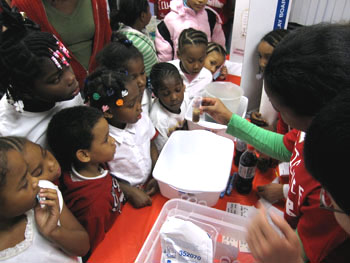Middle School Outreach Program Inspires Future Scientists
 |
| Middle school students conduct experiments for younger members of the Science Club at the Uptown chapter of the Boys and Girls Club. |
Chicago-based science experts had their audience “ooh-ing” and “ahh-ing” at a bustling fair Wednesday. A 10-week session packed with experiments and lectures culminated in the scientists flaunting their newly-acquired skills with the help of liquid nitrogen, carbon dioxide, and homemade pH paper.
Only the setting wasn’t a university and the experts weren’t PhDs. In fact, none of them have even graduated from middle school.
The “experts” are members of Science Club, a collaborative project between Northwestern University and the Uptown chapter of the Boys and Girls Club. The club was designed to spark and maintain an early interest in science among school-aged children. And the “audience” brought together participants from other Boys and Girls Club programs and a handful of parents.
Carolyn Jahn, PhD, associate professor of cell and molecular biology and a member of Northwestern’s Center for Genetic Medicine, said she and the two other organizers focus on fifth-through eighth-grade students for the program. Statistics show that once kids hit middle school, their interest in science sharply declines, but you’d never guess that at the Science Club. Budding scientists in lower grades joined the club as well.
Northwestern students volunteer their scientific know-how, working with the younger kids to “keep them excited about science, teach them more science, have them do tons of hands-on activities, and make them really enthusiastic going into high school,” said Dr. Jahn.
“We designed the program to be a mentorship program,” said Michael Kennedy, PhD, director of education and research programs at Northwestern’s Center for Genetic Medicine, and another coordinator behind the club. “It’s not just come in and do an activity and leave. We want to get to know these kids and begin to work with them and encourage them to shoot high as far as science and math go.”
Jenny Linh, a fourth grader at John T. McCutcheon School, expressed a zest for science and said she’s already considering making a future career out of it. “I might be a scientist and show kids how to do all of a lot of stuff!” she exclaimed.
Nine-year-old Linh helped grab the attention of onlookers with her group’s pH-indicator presentation. “I learned a whole lot and today I am showing other people about tie-dye cabbage paper” that can be used to tell how acidic a substance is.
Last spring, the inaugural session of Science Club offered a genetics-themed series. This fall, the group focused on chemistry in meetings twice a week, to accommodate the growing student interest.
Myrlyn Duong, one of the youngest members of the group, hosted an experiment that demonstrated how carbon dioxide can be created with two stock household items. “They liked the vinegar and the baking soda,” Duong said of observers. “We put in three baking sodas and one scoop of vinegar and then it exploded and spilled.” The McCutcheon second grader said she’s only visited her school’s science class twice.
Dr. Kennedy said the school is suffering from low math and science scores and now has a Chicago Public School facilitator on-site to work toward improving scores. And the Science Club is doing the same.
“The kids need a boost to see that this is fun and can be engaging, so we’re trying to complement the work of the school,” he said.
Christian Cardenas, 11, said the fair-goers who visited his table were so excited about the pH acid and base experiment he demonstrated, they wanted to lend a hand.
At the close of the fair, the kids received certificates of completion, which left many members beaming. But they can look forward to more science in 2009.
Come January, Science Club members will learn in a pseudo-forensics atmosphere, with investigative activities such as hair analysis just like on the popular TV show CSI: Crime Scene Investigation. And sometime after that, the kids may be able to learn in their own science lab at the club, a project that’s in the early planning stages.
So with the success of the current club, where do Drs. Jahn and Kennedy, and Michael Anderson of the Boy and Girls Club see it headed in the future?
“The sky’s the limit,” Dr. Kennedy said. “We would love to see it expand to different centers within Chicago.”
Julia Dilday, Medill Reports






